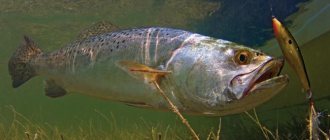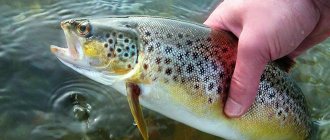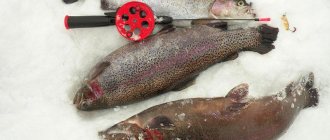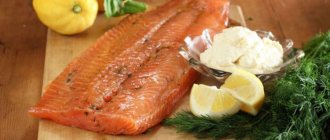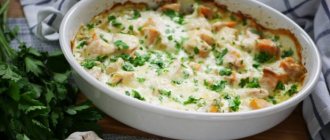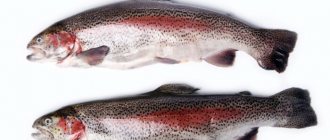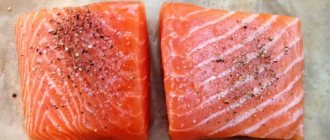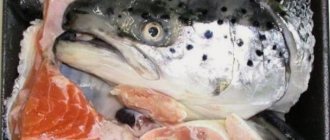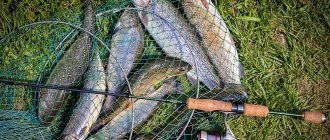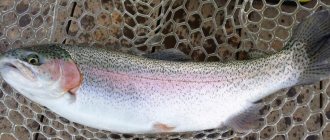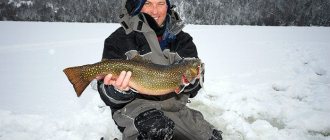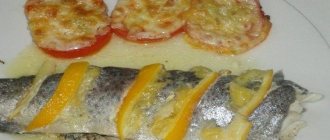Trout fishing is undeniably becoming more accessible every day. What contributes to this is not the improvement of the ecological situation, which, of course, would be desirable to a greater extent, allowing this fish, which loves crystal clear water, to reproduce, conquering more and more new bodies of water suitable for habitation, but the creation of artificial ponds populated with river trout for commercial fishing. For most fishermen, catching trout in natural conditions remains only a cherished desire, which can be fulfilled far from places of active human activity.
Well, if there is still a choice of fishing places that provide such opportunities, then sooner or later the fisherman, due to his curiosity and replenishment of the list of trophy fish, will master this interesting technique with its nuances and secrets, which will be facilitated by his familiarization with the information presented in the article below, telling what is the best way to catch trout depending on the method of hunting and the season of the year.
About trout
Trout fishing is not complete without knowing basic information about this fish, which seems to be widely known to any average person, but this does not make it a more common trophy in the catches of most anglers. Trout is a bright representative of the salmon family, which has a huge number of species living in fresh waters. Due to their place of residence, the population is divided into river and lake forms, which, by the way, easily adapt to the lifestyle when changing the area without any consequences for themselves, flowing from one subspecies to another.
Trout or brown trout are cold-loving species that prefer to live in waters with temperatures not exceeding 20 degrees. Also, fish are sensitive to the saturation of water with oxygen and the presence of all kinds of suspended matter that reduces the transparency of water, thus becoming a natural indicator of the cleanliness of any body of water. The average size of the fish is about 40 cm with a weight of 0.7-1 kg. Larger specimens, both when fishing for brook trout and lake trout, are rightfully considered trophy and are caught quite rarely in catches.
Features of trout fishing
Trout fishing has three main directions. The simplest and most inexpensive method is float fishing . To hunt for a trophy using a fishing rod, there is no need to master special fishing techniques or buy rare baits. Fishing by fly fishing is considered a complex and expensive method. Fly fishing gear for trout fishing, as well as lures of this type, have their own specific configuration and production, belong to one of the elite areas of fishing and require mandatory acquisition of skills for the technical execution of techniques for presenting bait and performing retrieves.
Spinning fishing is a type intermediate in technical complexity between float and fly fishing and, apparently, this is why the method has many fans, especially in commercial pond trout fishing. Recently, special attention has also been paid to the direction of feeder fishing, which is especially successful in the pre-winter period when the predator moves to the depths.
When to catch trout
Trout fishing begins with the disappearance of ice from the surface of reservoirs. Melt water activates the fish, which begins to gain lost mass after the winter hungry period. Until the water warms up significantly, and this period lasts until the beginning of June, the bite is relatively stable and is especially good in the afternoon. In summer, the intensity of bites noticeably decreases, and the predator is active only in the early morning, in cool water. In a mountain river where the flow is fed with meltwater throughout the summer, fish will be active throughout the day.
With the arrival of autumn, the most active phase of fishing for this fish begins . The cooling of the water gives a signal for the start of preparation for spawning, and the fish begin to fatten, starting to feed around the clock, including their dark time. The spawn itself is distinguished by a pause in feeding, after which there is a transition to the winter season of the relatively passive behavior of the predator.
Important! Trout does not like prolonged rains, which bring turbidity to the water and reduce atmospheric pressure.
Stable weather with constant atmospheric pressure and lack of precipitation for three or four days gives a good chance for a stable and intense bite.
Missing link
One day in the summer, while wading, I noticed that in the evening, despite the cloudy weather, the water felt warmer than during the day, when it was sunny and calm. Immediately, a thought flashed through my mind: isn’t the trout bite related to the water temperature? I knew from books that trout prefer cold, oxygenated water.
During the week, I was not lazy and bought an alcohol thermometer at the pet store. It was not by chance that I chose alcohol because of its environmental safety and the ability to instantly show the temperature as soon as it touches the water. Arriving at the river a week later at lunchtime, I immediately measured the water temperature. It turned out to be 18 degrees. I started fishing with a spinning rod, and, despite the sunny weather, I caught and immediately released a couple of trout weighing 400-500 grams (in our team it is customary to release trout less than 600 grams). Around 7 pm the biting stopped completely. That is, the trout even stopped going after the spoon. I'm taking the temperature. Wow, it’s already 20 degrees Celsius! From that moment on, statistics began to be collected.
I measured the water temperature on each trout fishing trip, recording the start of fishing, the beginning of the bite, the end of the bite and the end of fishing. In order not to forget this data, I immediately wrote it down in a small notebook, and then transferred it to a fishing diary with a description of the details.
Having collected a sufficient amount of statistics, I made the following conclusions: In any calendar period, the temperature in the river changes throughout the day. Trout activity peaks at one of the extreme temperatures. Trout bite best at the temperature that is closest to optimal for the digestion of a cold-blooded creature at a given time of year. In winter, spring and autumn, the best bite occurs when the water temperature rises. In summer, on the contrary, the bite occurs when the water temperature drops. Now - a little more detail.
Where to fish
You can catch trout in natural conditions on the rapids of mountain rivers and in cool streams, as well as in lakes, into which these cold streams and rivers, fed throughout the year with melt water, directly flow. Under natural conditions, the predator prefers to stay in a small flock on the currents themselves or in border waters, guarding insects falling on the water or passing food objects in the water column.
Larger individuals go to depths in relatively calm waters, hunting from ambush in the form of bottom anomalies, hiding behind boulders and in snags. The fish can stand in mid-water under steep cliffs and the crowns of trees overhanging the water, rising to the surface for food falling on the water.
Important! When choosing places on rivers, they focus on fast currents; when hunting on lakes, they look for bottom anomalies.
Artificial water structures are also not ignored. The predator is especially attracted to bridge supports, behind which the fish stand in schools, snatching fry and drowning carrion of insects from the rapids of the main current. In artificial conditions, for paid fishing, fish are bred in ponds, where solid bottom foundations are replete with small differences in depth, providing predators with places to hide and hunt.
Do fish bite in rain and wind?
Weather and fishing are interconnected things. Experienced fishermen know that in order to return home with a good catch, skill alone is not enough. It is also important to take into account weather conditions, which greatly affect the bite.
Weather factors affecting fish bite
Most fishing lovers combine it with outdoor recreation, so they go to the pond in good weather. But weather conditions that are comfortable for humans do not always coincide with the activity of the inhabitants of the reservoir. The fish can bite well in rain and cold, fog or frost. Therefore, experienced fishermen are ready to endure any conditions.
However, even experts in their field cannot always predict what weather is best for fishing. When determining the best time for a bite, the following factors must be taken into account:
- air temperature;
- Atmosphere pressure;
- wind force;
- cloudiness;
- precipitation intensity.
The bite is also influenced by the characteristics of the reservoir and the current. The depth and transparency of the river or pond must be taken into account. Sometimes these factors are more important than weather conditions.
Air temperature
Often the temperature outside is the decisive reason why the fish don’t bite. These cold-blooded inhabitants of the deep waters are sensitive to temperature changes. Moderate warmth is the most comfortable temperature for them. However, experienced fishermen know how to ensure a good fish bite during temperature fluctuations.
In hot weather, the catch will be scarce, as the fish lie on the bottom in search of cool places. In such cases, it is better not to wait for a bite with a fishing rod on the shore, but to set the nets at night, when the fauna will be more active. Often in the summer heat, fishermen go to the reservoir early in the morning, when the air has not yet warmed up much.
A slight cold snap is considered the most favorable time for fishing. In cold weather, the fish need more food and begin to rise to the surface. But this tactic will not work in cold weather, since the inhabitants of the reservoir wait out the frosts at the bottom, where the water is warmer.
Atmosphere pressure
Fish feel fluctuations in atmospheric pressure better than humans, since this factor affects their movement in the water. Under normal conditions, the fish moves and stays in the water thanks to its air bladder. But with atmospheric fluctuations, its air bubble ceases to function normally. The fish loses coordination and lies on the bottom.
Too low or high atmospheric pressure is a negative factor and an unfavorable time for fishing.
Normal atmospheric pressure for fish 770 will ensure a good catch. But it’s even better to wait for a period of lowering pressure. The inhabitants of the reservoir sense the approach of unfavorable conditions and begin to actively search for food.
What kind of wind does the fish bite in?
It is equally important to have information about which wind the fish bite better in. Most often, wind indicates a change in weather. This factor can either help or hinder. The main thing is to determine the direction of the wind. If a cool north wind blows after a hot day, it will cool the pond and the fish will rise. The same happens when the surface of the water is heated by a warm wind. This, for example, happens with an easterly wind. But the western wind is considered the best for fishing.
The effect of wind on fish bite is easy to track. A light breeze is very favorable for fishing. Ripples in the water wash the food onto the shore. The inhabitants of the reservoir do not see what is happening on the surface and boldly wash up on the shores in search of food. You should not suffer and go ashore in a strong cold wind, since there will be no bite in such conditions anyway.
Cloudiness
Cloud cover also helps determine the time of a successful bite. In hot weather, representatives of the fauna hide deep in the shade. If clouds appear in the sky and cover the sun, then the inhabitants of the reservoir will approach the surface in search of food. The same thing happens when the water warms up after a period of heavy cloudiness. But the best weather for biting is partly cloudy.
Precipitation intensity
The inhabitants of reservoirs do not like heavy rainfall. Rain or snow scares away fish. Fishing in rainy weather will be successful if there was intense heat before the precipitation. Rain will lower the temperature and cool the pond.
In what weather does the fish bite better?
The influence of weather on fish biting, stable wind direction, atmospheric pressure and other factors are important to consider, but the season also matters. In addition, each season has the best periods for fishing. Therefore, experienced fishermen prepare their gear in advance, knowing that a favorable period will soon come.
In summer
In summer, it is best to go to the pond at dawn. The activity of aquatic inhabitants continues until lunchtime, when the sun heats the air. However, a summer day can also become fishy; fish do not go deeper in the rain, as precipitation cools the reservoir. Rain should be moderate and without strong gusts of wind.
in autumn
Autumn is the best time for fishing, as many aquatic species prefer cool weather. For fishing in the fall, it is important to decide on the weather. It should be a slight cold spell with light wind or rain. Therefore, it is better to go to the reservoir at the end of September or October.
in winter
In winter, the pond is always cold. But when the sun is shining, representatives of the fauna become more active. Positive weather factors in the morning and evening hours contribute to the bite. The worst catch is at night and in the middle of the day. However, in winter it is important to monitor the strength and direction of the wind and atmospheric pressure.
in spring
The spring months are a great time for fishing. However, you should not run to the reservoir at any time of the day, since the determining weather factors are warmth and a small amount of precipitation. When the ice begins to melt, the inhabitants of the reservoir become active. During such a period it is necessary to collect gear. Spring fishing in the rain, if it is warm and drizzling, will also produce a good catch.
What weather is bad for fishing?
Most of all, fish do not like severe frosts or heat. It ceases to be active and lies to the bottom. Strong wind or rain can interfere with the bite. During such periods, the inhabitants of the reservoir are also in no hurry to rise to the surface, but wait out the bad weather in calmer places.
However, experienced anglers believe that there is no such thing as bad weather for their favorite hobby. You just need to know where the fish are hiding. In bad weather, it can accumulate at depth, so it’s worth taking a boat and going out to the middle of the pond.
In strong winds and currents, representatives of the fauna hide near the shore in the mud or plant roots. That's where you need to sit down with a fishing rod.
ribaku.info
Trout fishing gear
Trout fishing is provided by a set of gear made from universal tools and materials available to the fisherman at each fishing retail outlet. Only when assembling fly fishing gear can some difficulties arise, requiring narrow specific knowledge regarding both the rods themselves and the composition of the cords. In further information, the angler will be presented with directions for choosing various gear for trout fishing, ensuring the catch of a predator in natural conditions and in the conditions of a paid pond.
Spinning
Trout fishing in the fall is most successful using spinning rods. The fish, starting to actively feed, becomes an energetic and sharp predator with aggressive behavior, sensitively responding to the placement of artificial baits in different water horizons. For fishing, spinning rods of semi-fast and fast action are selected. Ultralight tackle and tackle for supplying baits of 15–20 grams are optimal for catching predators according to their test characteristics. Since fishing can be done from boats and shorelines, spinning rod lengths vary from 1.7 to 2.3 meters when fishing from a floating craft, and for the shore, with the expectation of long-distance fishing, fishing rods with a length of 2.5 to 3.2 meters are used .
Lake trout fishing, like brook trout fishing, is universal in the selection of spinning equipment, which includes spinning reels with a high gear ratio and braided cords of small diameters, rarely exceeding a thickness of 0.15 mm. Wary fish require delicate rigs that are not overloaded with accessories in the form of ineffective leashes and bulky fasteners that make the rigs rougher and, therefore, less attractive to predators. Spinning fishing is done using wobblers, spinners and silicone baits. In some cases, it is rational to use live fry, fish fillets and pastes specially prepared for trout fishing.
Fly fishing
Trout fishing in mountain rivers and fast streams is the domain of fly fishing equipment. For fly fishing, a lightweight prefabricated fishing rod up to 2.5 meters long is equipped with an inertial reel with a reliable braking system. The volume of the reel should allow it to accommodate the main thick cord and its working part, which is selected depending on the fishing conditions and the use of the bait in a floating or sinking version.
It is difficult to catch trout in winter or autumn with fly fishing, since the fish goes to the bottom horizons, where they mainly feed, but at the end of spring and throughout the summer season, especially when the mayfly emerges, this type of hunting is considered the most promising. Fly fishing is done in a wade, so as additional equipment, the angler will need to purchase waders or a floating raft, which make fishing not only more comfortable, but also much more successful in terms of choosing promising points and camouflaging the angler himself.
Important! The main lures in fly fishing are artificial dry and wet flies.
Also quite often, and it is especially effective to do this after their flight, natural insects are used.
Float rod
An effective fishing method is a float rod, or rather, a Bolognese version of this type of tackle, equipped with an inertial reel with a large drum, which allows fishing with bait swims over long distances. Telescopic fishing rods 6-7 meters long are selected from the lightest materials, graphite or carbon fiber. For fishing, a braided cord with a thickness of 0.10-0.12 mm is used at the end with a meter-long nylon leash of 0.12-0.14 mm. Hooks for trout fishing are selected based on the type of bait. Most of the selected accessories have an elongated fore-end with hook numbers from 10 to 14.
Important! They are caught with float tackle in the spring months and throughout the entire autumn season, when the predator switches to feeding in the middle water horizons.
Plant and animal baits are used as bait. Under some conditions, the predator can also be caught using wet artificial flies.
Feeder
The feeder is not as popular as all the hunting methods described above, but its effectiveness deservedly needs to be discussed during the pre-winter period, when the predator goes to the deepest points of reservoirs, which is especially important for paid ponds. For fishing, rods with a length of 2.8 -3.5 meters are used, with test parameters no higher than 50 grams. Choosing the right bait with the ability to boil and create a distinct spot of turbidity attracts predators from afar, making fishing from the bottom quite successful. The rigs are knitted from monofilament, using nylon or transparent fluorocarbon leashes one meter long in the rig, equipping the hooks with animal baits or a bright and fragrant paste.
Annual cycle
Probably in all the books whose authors dealt with trout fishing, it was written in black and white that it is best to catch trout both on a spinning rod and on a fishing rod throughout the whole year in spring and autumn. I won’t immediately refute this, because everything may be different in different areas, but as regards trout fishing specifically in Belarus, this stereotype is completely wrong. Practice shows that the highest results in trout fishing with a spinning rod (not with a fishing rod!) can be achieved in the summer, in the very heat. Moreover, if in the spring the bite is good on one day, and on another, one might say, none, then in the summer the trout takes very consistently every day.
Naturally, if the day is cloudy, with light rain, then the bite is much better, but in general it’s quite difficult to completely “fly by” and not catch anything. This stability of the bite cannot be explained except by the optimum temperature in the river. Moreover, just when summer begins, the water temperature rises so much that the trout becomes most active and feeds better than at any other time, for example, late autumn or spring.
Based on the analysis of entries in the fishing diary, which I have been keeping for more than 12 years (and I go fishing at least twice a week), it follows that in Belarus, daytime water temperatures in summer in trout rivers are approximately in the range from 10 to 18 degrees of heat. This trend continues throughout June and almost until the end of July. Even when the swimming season is already in full swing, the temperature of trout rivers remains quite low. Often, walking along a trout river in the heat and accidentally meeting float fishermen, you catch surprised looks at yourself - they say, why does he want to catch trout in such and such heat, after all, even the crucian carp has become soft from the heat! Usually, to the snide question: “How is it biting?”, I answer that it’s strange, but not at all, and move on. How surprised they would probably be to see my real catch! But the trout fisherman is a man of few words and, apparently, that is why the beautiful fish has not yet disappeared from numerous grabbers and poachers.
You can understand the floaters, because in the nearest pond, where they usually catch their crucian carp, the water is almost boiling, and all living things are in a half-asleep state. But other processes take place in the trout river, and everyone doesn’t need to know about them!
This situation continues until the end of July, and then the cold spring rivers gradually begin to recede under the pressure of the heat. During this period, the water temperature in them already exceeds 20 degrees, and the trout also begins to hibernate, that is, it becomes motionless and does not feed at all. By the way, as Sabaneev himself wrote, during this period you can really easily catch trout with your bare hands, putting them under a washed-out bank or snags, you can even stroke it. Where have her lightning speed and famous caution gone now?
Statistics show that this “dead” period lasts, depending on weather conditions, 2-3 weeks. Even rain cannot bring trout out of their short “summer” hibernation! Every year the time of this hibernation shifts slightly in terms of timing, but it is definitely present.
Around mid-August, trout begin to wake up, and this is no wonder, because the day has already begun to wane and the heat has begun to subside. Trout are very active during this period, and they feed again all day. Spawning is coming soon, and you need to gain more strength. The water temperature during the day is again in the optimal range, from 12 to 16-17 degrees. By the end of September, the peak of the bite begins, and after a few weeks, all the trout, which are preparing for spawning, “lose” (that is, change color) and stop responding to spinning baits. For a true trout fisherman, this is a sign that the trout season is already over. Now you can only catch small things that are not capable of spawning, and this is unsportsmanlike!
What to catch trout with
Trout bait is varied in its composition and structure. The only feature that distinguishes these baits from baits for other types of predators is their miniature and small size. This is directly related to the physiology of the fish, which does not have a very wide mouth. In natural conditions, fish are more involved in gathering than directly hunting. A favorite pastime of trout is collecting insects that have fallen to the surface or picking up floating food in the water column. Fish are sensitive to attractants, especially the tastes of fish oil, shrimp and fish fillet itself.
In addition to insects, the predator likes to feast on worms, bloodworms and maggots, which floaters often use, and will also not refuse pieces of fresh fish meat, shrimp or crayfish. But the greatest interest of anglers is caused by the possibilities of hunting fish using artificial baits, the most popular types of which we will present in the continuation of the article.
Wobblers
Trout wobblers are used in spinning fishing and predator fishing using a bombard float. The best options for this kind of bait are cranks, with the ability to play their own game, which is distinguished by its fine frequency and the creation of a strong vibration wave, which causes additional interest in nearby fish. Wobblers of small masses from 2 to 10 grams with bright colors, which are preferable for contrasting highlights on gray and black tones in the form of dots, are carried out on uniform movements in different water horizons, looking for promising levels of fish parking. During the period when predators are feeding from the surface of the water, small-sized poppers are ideal for fishing. Retrieving surface baits is carried out in a jerking manner.
Spinners
This type of bait is applicable in shallow waters where water levels do not exceed 3–4 meters. Mepsian pinwheels with oval petals, the Aglia type, of the smallest size are considered a classic hunting tool. By analogy, trout fishing enthusiasts select baits from other brands or make spinners of a similar type on their own. Typically, silvery petal base colors with dots of red and blue are the most catchy. The spinners are driven through the water column at medium speed, without pauses or stops, with the tool lowered to the bottom. Lake trout bite in the water column, attracted by the vibration and glimpses of the petal.
Microoscillators
This type of spinner is no less popular than spinners, and in terms of color design, promising spinners are similar to the rotating type of spinner.
Important! The trapping tool must have a distinct point of attack.
In combinations with a spinner, flies are used that are attached to the tees of the spinner itself or launched on a separate leash next to the leading bait. An excellent example of a spinner for trout fishing is the castmaster spinner, the wiring of which is done in the water column in the form of a step in a calm and non-aggressive style. Trout spoons rarely exceed a mass of 10–12 grams and a length of 4–6 cm.
Silicone baits
Silicone simulators of all kinds of small fish, insects and aquatic inhabitants are a fairly catchy and inexpensive bait for trout. In trout fishing, silicone is used both as the main bait and as an auxiliary bait, retrofitting them into the tees of spinners. Silicone is served on stationary jig heads or in spaced equipment.
As a rule, the length of artificial fish does not exceed 5–7 cm, and vibrotails look more preferable for a predator. Slugs in the form of worms and crustaceans have also established themselves as forms of particular interest to predators. The use of edible rubber with the smell of fish oil and meat, especially in the autumn, significantly increases the number of attacks by predators. Silicone in eye-catching, unnatural colors is suitable for trout fishing. Postings are carried out using the jig fishing method, trying to make steps without the bait touching the bottom.
For trout paste
One of the innovative types of trout bait is paste. This plastic bait is made on a base of plant dough, in which manufacturers include various elements that attract trout to the fishing zone with their scents. Each manufacturer has its own recipe for preparing the composition, the ingredients of which are kept secret. Fishing practice shows that the bait can be considered universal, used in float, spinning and feeder fishing throughout the year. Fishing for trout in winter on ice from ice also cannot be done without the use of paste; choosing from a wide range of scents and colors, you can always find the key even to fish that are passive at this time of year.
Important! Trout paste is used to make balls and shapes in the form of worms and fish, which are used to equip hooks.
Incredibly distinct color schemes complement the taste appeal of the paste, making it a must-have attribute of trout hunting.
In winter time
Trout fishing in winter on paid reservoirs is rapidly gaining popularity. During this period, fishermen practice the following directions:
- balancers;
- vertical spoons;
- winter float rod;
- large jig;
- girders and supplies.
Each direction has its adherents. Fishing with artificial bait is more dynamic, but it is difficult for beginners to immediately master all the intricacies of playing with a spoon or balancer. Fishing with a rod is easier, but it is a static activity. If the bite is bad, then sitting motionless on the ice is boring.
What do they use to catch trout on paid sites?
Paid fishing for trout, mostly in stagnant reservoirs and in conditions of comfortably equipped coastlines, is carried out using spinning and float fishing during the period of open water and for winter girders and winter spinning from ice. The rules of paid ponds only in rare cases allow hunting a predator using live bait and animal baits, and for the most part fishing on ponds is carried out only with artificial baits. The most common are rotating and oscillating spoons, silicone and wobblers, as well as trout pastes. When visiting the same body of water, fish preferences become noticeable in terms of responsiveness to a particular bait and its color design, which should definitely be taken into account in strategies for this body of water when planning future fishing trips.
Bait recipe
On stagnant and weakly flowing reservoirs, it is important to use bait for trout, which is mandatory when fishing with a feeder and obviously does not hurt when hunting with float gear. Bait helps to further attract fish to the fishing zones. Fishing stores sell special mixtures for trout, but knowing the principles of bait formation and its basic fish-attracting properties, the mixture can easily be made independently at home. The basis of the bait is fishmeal with trout pellets. An attractant with the smell of shrimp, squid or fish oil is added to the ingredients mixed in equal quantities.
The secret of trout mixtures is the presence in the mix of substances that cause geyser effects, with the release of nutrient particles at certain intervals into the water column and bright dyes. Geysers are special components sold in fishing nets as additives to bait. If you regularly feed a certain place with this kind of mixture, the trout will stay close to the point and react to any given bait not only if they want to eat it, but also by reflexive actions of protecting a territory that is favorable in terms of nutrition.
Bait for trout
Trout is one of those fish that you can not be afraid of overfeeding. They always show interest in food if it has a bright smell and color. Therefore, you need to select the appropriate bait: with an intense fishy or shrimp smell, a desirable red hue. The substance, dissolving in water, should create a cloud that will attract fish. The easiest way is to buy a ready-made composition at a fishing store.
In order for bait to give greater results, you should choose a specific place on the pond and periodically leave it, increasing the interval between baits. You should start with a frequency of 1-2 hours, and then you can increase the gap to 1 week. Even despite such a large time difference, the fish will continue to come to the place it remembers in the hope of easy prey.
Article on the topic: Characteristics of catchable trout spoons
